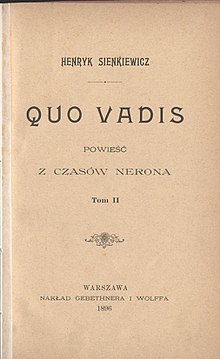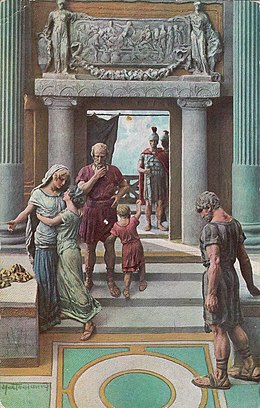
Back كوو فاديس (رواية) Arabic Quo vadis (роман) Bulgarian Quo vadis? Catalan Quo vadis Czech Quo vadis Danish Quo Vadis (Roman) German Κβο βάντις (μυθιστόρημα) Greek Quo vadis? Esperanto Quo vadis? (novela) Spanish هوسهای امپراتور Persian
 | |
| Author | Henryk Sienkiewicz |
|---|---|
| Original title | Quo vadis. Powieść z czasów Nerona |
| Translator | Jeremiah Curtin W. S. Kuniczak Samuel Augustus Binion |
| Language | Polish |
| Genre | Historical novel |
| Publisher | Polish dailies (in serial) and Little, Brown (Eng. trans. book form) |
Publication date | 1895–1896 |
| Publication place | Poland |
| Media type | Print (Newspaper, Hardback and Paperback) |


Quo Vadis: A Narrative of the Time of Nero is a historical novel written by Henryk Sienkiewicz in Polish.[1]
The novel Quo Vadis tells of a love that develops between a young Christian woman, Lygia (Ligia in Polish), and Marcus Vinicius, a Roman patrician. It takes place in the city of Rome under the rule of emperor Nero, c. AD 64.
Sienkiewicz studied the Roman Empire extensively before writing the novel, with the aim of getting historical details correct. Consequently, several historical figures appear in the book. As a whole, the novel carries a pro-Christian message.[2][3][4]
It was first published in instalments in the Gazeta Polska between 26 March 1895 and 29 February 1896,[5][6] as well as in two other journals, Czas and Dziennik Poznański, starting two and three days later.[7][8] It was published in book form in 1896 and has been translated into more than 50 languages. The novel contributed to Sienkiewicz's Nobel Prize for literature in 1905.[9]
Several movies have been based on Quo Vadis, including two Italian silent films in 1913 and in 1924, a Hollywood production in 1951, a 1985 miniseries directed by Franco Rossi, and a 2001 adaptation by Jerzy Kawalerowicz.
From May 2024, a copy of the novel in the author's own hand is presented at a permanent exhibition in the Palace of the Commonwealth in Warsaw.[10][11]
- ^ Halsey, F. R. (5 February 1898). "Historians of Nero's Time" (PDF). New York Times. p. BR95. Retrieved 2 January 2009.
- ^ "The Man Behind Quo Vadis". Culture.pl. Retrieved 16 February 2018.
- ^ Socken, Paul (1 September 2013). The Edge of the Precipice: Why Read Literature in the Digital Age?. McGill-Queen's Press – MQUP. ISBN 9780773589872.
- ^ Soren, David (2010). Art, Popular Culture, and The Classical Ideal in the 1930s: Two Classic Films – A Study of Roman Scandals and Christopher Strong. Midnight Marquee & BearManor Media.
- ^ "Gazeta Polska 26 March 1895" (in Polish). Retrieved 8 November 2018.
- ^ David J. Welsh, "Serialization and structure in the novels of Henryk Sienkiewicz" in: The Polish Review Vol. 9, No. 3 (1964) 53.
- ^ "Czas 28 March 1895" (in Polish). Retrieved 8 November 2018.
- ^ "Dziennik Poznański 29 March 1895" (in Polish). Retrieved 8 November 2018.
- ^ "International Conference, "Quo vadis": inspirations, contexts, reception. Henryk Sienkiewicz and his vision of Ancient Rome | Miejsce "Quo vadis?" w kulturze włoskiej. Przekłady, adaptacje, kultura popularna". www.quovadisitaly.uni.wroc.pl. Retrieved 16 February 2018.
- ^ "Palace of the Commonwealth open to visitors". National Library of Poland. 28 May 2024. Retrieved 11 June 2024.
- ^ Makowski, Tomasz; Sapała, Patryk, eds. (2024). The Palace of the Commonwealth. Three times opened. Treasures from the National Library of Poland at the Palace of the Commonwealth. Warsaw: National Library of Poland. p. 166.
© MMXXIII Rich X Search. We shall prevail. All rights reserved. Rich X Search